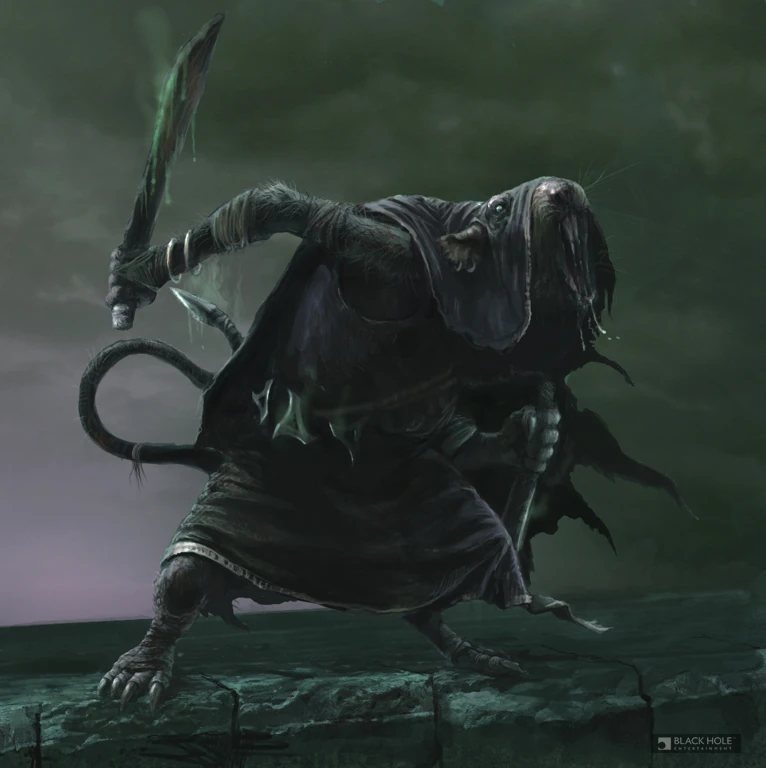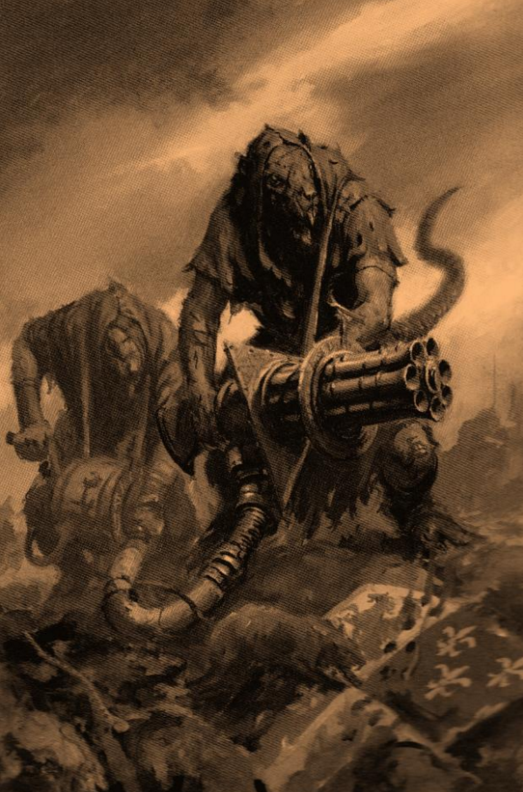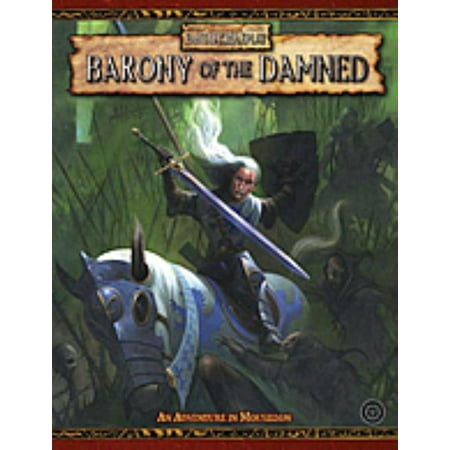Night's Dark Masters (April 2007)
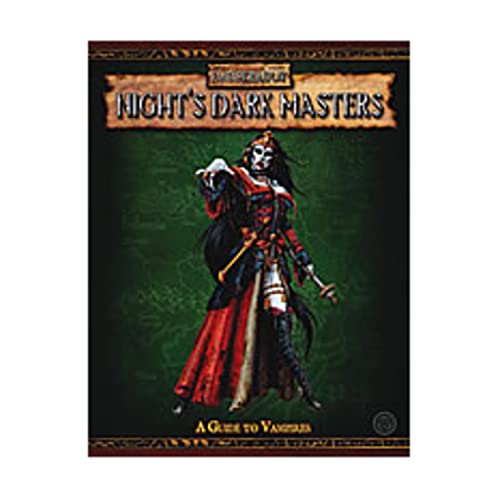
Did you ever look at Warhammer Fantasy Roleplay and think: 'this is alright, but it would be much better if it was more like Vampire: The Masquerade?' If so, this is the book for you! It provides a history of the vampires of the Old World, an account of the different clans they belong to, rules for their vampire super-powers, and a description of how the nations of the Old World have been infiltrated by super-secret vampire conspiracies, requiring the humans to create counter-conspiracies of vampire hunters to fight them. Like I said, Vampire: the Masquerade. There are even rules here for playing vampire characters, if you really want to. And, yes, Geneviève Dieudonné gets name-checked, although I could have lived without the revelation that her heroic deeds are secretly tolerated and protected by one of the vampire conspiracies in order to trick people into believing that vampires aren't really as bad as all that.
Even though it came out in 2007, this book's 'vampires with everything!' approach to the Old World feels as though it has its roots firmly in the great vampire boom of the 1990s. (I'm guessing a lot of its lore is drawn from the 1999 Vampire Counts army book for WFB? I haven't read it.) Hunting down an individual vampire in some ruined castle or God-forsaken slum fits in with the tone and spirit of WFRP just fine, but I'm not sure about all these vast and secret vampire organisations. It feels to me as though you'd only be able to use most of this book if you were willing to make your campaign all about vampires, either by having the PCs actually be vampires, or by having them as a crew of dedicated vampire hunters. In a more traditional WFRP campaign, in which a vampire would be more likely to appear as a one-off antagonist, I struggle to see why you'd need a 143-page book about them.
(Klaus Gerken now has a perfect right to call me a hypocrite, because all the same objections could be raised to the skaven book. I guess I feel that the skaven need more specific information because they're a much more specific concept, whereas everyone already knows what the deal with vampires is, and this book offers very little in the way of new interpretations. Besides, the skaven lose most of their meaning and significance without their vast, mad Under-Empire, whereas vampires work just fine without all these clans and conspiracies and whatnot.)
Anyway. Turns out there are fighter vampires and wizard vampires and sexy vampires and ugly vampires and Dracula vampires. (Geneviève, naturally, is one of the sexy vampires.) There are loads of them and they're all really powerful, but they're also so super-secret that everyone thinks the vampire hunters are crazy for making such a fuss about them. It all seemed a bit much to me, but then I know that some people felt that way about the skaven book, too, so maybe I'm just biased. What I really wanted from it was a Barony of the Damned style write-up of Sylvania, but the chapter on Sylvania is very brief, presumably to make room for all those multi-page clan descriptions. If you want to add fuckloads of vampires to your WFRP campaign, this is probably a great book. Otherwise I'd say it's skippable.
Tome of Salvation (September 2007)
 |
| Probably my favourite 2nd edition cover. You can view the whole image on the artist's DeviantArt page here. |
So this is a good book, and one that shows how far the depiction of Old World religion has come since the days of the original WFRP core book, which essentially just threw down a generic D&D fantasy pantheon - Druidic nature god, god of death, goddess of healing, god of thieves, goddess of knowledge, goddess of war, god of the sea, god of elves, god of dwarves, goddess of halflings - and called it a day. (I still miss the gods of Law, though.) However, I feel that the Tome's main strength may also be its greatest weakness: few WFRP campaigns are really going to need this level of detail on religion, and in most games a more rough-and-ready approach might actually be more gameable than the more exhaustive treatment of the subject offered here. If you wanted to run a densely detailed 'simulationist' game set in the Old World then you could get a lot of use out of this, but most campaigns could probably have got by just as well with a book that was half the length.
Realm of the Ice Queen (November 2007)
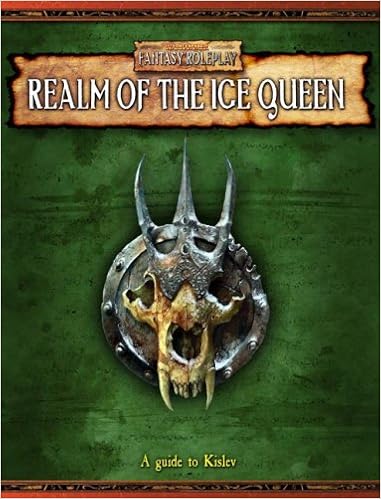
This book covers Kislev, the Old World's analogue for Russia. Like so much of the Warhammer setting, Kislev's status was beset by contradictory information from the wargame and the RPG. Something Rotten in Kislev (1988) drew upon a combination of medieval and nineteenth-century Russian history to portray it as a highly bureaucratic state ruled by Tsar Radii Bokha, in which an ethnically Norse aristocracy presided over a combined Ungol (= Mongol) and Gospodar (= Slav) population, and tried to cope with pressure from the Hobgoblin Hegemony to the east. The Empire Army Book (1993) confused all this by asserting that Kislev was in fact ruled by a Gospodar ice sorceress named Tzarina Katarin, who inherited her magical ice powers from the ancient Khan-Queens of the Gospodars, who had once been the terror of the Empire. It also introduced the idea that Kislev's military elite were 'Winged Lancers', modelled on the Winged Hussars of early modern Poland.
Some of the oddest elements of Realm of the Ice Queen clearly have their roots in this contradictory source material. The idea that it was the Gospodars who rode out of the steppes and subjugated the Ungols, and not the other way around, reads like some kind of bizarre revisionist fantasy of Russian history, but I'm sure it arose simply out of an attempt to reconcile the WFRP account (in which the Gospodars are stand-ins for the Slavs) with the WFB account (in which they're stand-ins for the Mongols). Kislev being ruled by a literal ice queen who lives in a giant castle made of magical ice right in the middle of the capital city sits rather oddly with WFRPs general low-fantasy vibe, but does accord with its WFB presentation. The obviously-Polish Winged Lancers seem strange in a setting which is obviously Russian in every other respect, but they're the single most iconic Kislevite unit from the wargame, so what were they going to do? As with the Bretonnia book, the authors had to work with the material they were given, and I think they did a pretty good job.
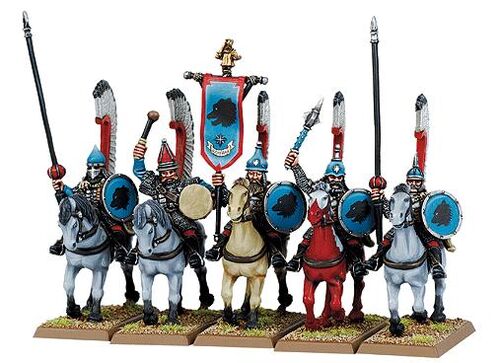 |
| Winged lancers from WFB. |
Slavic settings are weirdly under-represented in fantasy media and RPGs, and when they do appear, they usually just use the same handful of cliches over and over again: snow, bears, Baba Yaga, vodka, cossacks, and Russia's greatest love machine, Rasputin. There's definitely some of this in Realm of the Ice Queen, but, for the most part, they actually wrote a pretty decent fantasy Russia setting instead. There are a lot of bears and snow, here, and I rolled my eyes at the state religion being rewritten into the Cult of the Great Russian Bear God; but there are also streltsy, and firebirds, and steppe nomads, and other things which suggest some level of actual familiarity with the subject matter. It's a bit first-year-undergraduate-Slavic-studies-ish in places - did the coffee shop attended by radical intellectuals really have to be called Raskolnikov's? - but a genuine effort has clearly been made, and this version of Kislev is a setting which I'd happily run a game in.
Anyway. Realm of the Ice Queen depicts Kislev as a kind of combination of seventeenth- and nineteenth-century Russia. It's seventeenth-century insofar as Tzarina Katarin is depicted as being a Peter the Great style moderniser, employing the authoritarian methods of absolutist monarchy to drag her nation into the modern era. It's nineteenth-century insofar as it's also full of opera houses, intellectuals hanging around in cafes, and Tsarist secret policemen, which implies that quite a lot of modernisation has already taken place. (The secret police are an odd bunch. They're called 'Chekists', which obviously evokes the Bolshevik Cheka, but their description combines elements of Alexander III's Okhrana with the Oprichnina of Ivan the Terrible. Anyway, you can play one, which will probably come as a boon to anyone who's ever looked at the Witch Hunter career and said: 'Sure, this looks fairly morally murky. But is it morally murky enough?')
There's no mention of the Hobgoblin Hegemony, which seems to have been retconned out of existence, but there's lots of other good stuff: there are monsters inspired by Slavic folklore, gods based on Slavic paganism, and a good write-up of the chaos-blighted city of Praag, complete with bleeding cobblestones and specialist watchmen who roam the streets at night armed with metal hammers, looking out for restless corpses to whack on the head and throw into furnaces. In the provinces the frozen ground gets too cold to dig graves, so corpses are left out in the wilderness with their eyes removed, to ensure that if they rise again they won't be able to find their way home... which means that horrible blind undead roam the wild, looking for living victims so that they can steal their eyes. The Gospodar ice sorceresses are a bit boring, but the Ungol witches are much better than the Baba Yaga knock-offs they could so easily have been, guarding their homes by deliberately inducing hauntings in the surrounding woodlands, and raising mutant children in secret communities deep in the taiga for use as sacrificial fodder in their secret war against chaos. (Also they have a spell which turns them into eight-foot hags with iron claws and rusted metal teeth, which is way better than yet another minor variation on the theme of 'I use my ice magic to make things really cold'.) It's a bit long, but anyone interested in running a fantasy Russia game will find something worth stealing in here somewhere, and it makes me rather regret the fact that Black Industries never had a chance to take a crack at Estalia, or Araby, or any of the other neglected regions of the Warhammer World.
And for really, really old-school fans, there's a mention of the legend that a girl in a glass coffin lies hidden, sleeping, somewhere beneath the streets of Praag...
 |
| TOTALLY WAKING UP SOON, YOU GUYS. JUST A COUPLE MORE EDITIONS AT MOST! |









